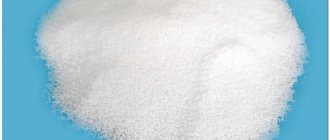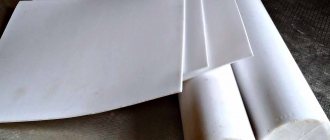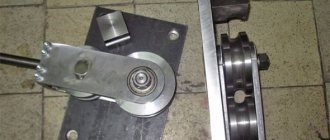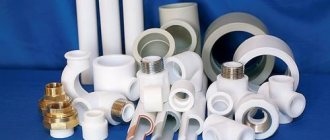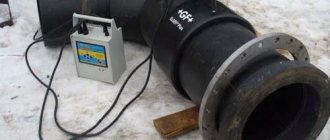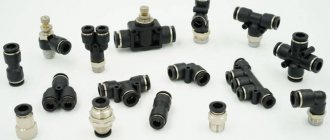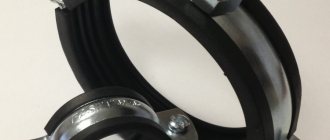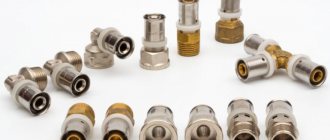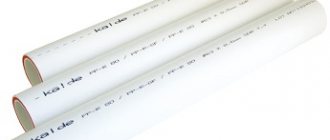Modern water pipes are rarely made of metal. It has worthy competitors - polymers, which are gradually replacing it in many areas. One such material is low-density polyethylene. Pipes for pressure pipelines, that is, for water pipelines and even gas pipelines, are made from this material. This type of material is becoming increasingly popular, since connecting polyethylene pipes is easy to do with your own hands. You just need to follow very simple rules.
When organizing private water supply, HDPE pipes are often used
Advantages and features of application
Polyethylene pipes are made from low-density polyethylene. This material is abbreviated as HDPE. It is characterized by increased strength and elasticity, and has good performance properties:
- chemically neutral, can be used for transporting food products;
- smooth walls prevent the formation of plaque inside;
- not subject to corrosion;
- small coefficient of thermal expansion - about 3% at maximum heating (up to +70°C);
- They react normally to the freezing of water inside, due to elasticity they increase in diameter, and after thawing they return to their original dimensions.
One point to remember! If you need pipes that are resistant to freezing (for example, for installing water supply in a country house), when choosing, look at the description or technical specifications. Not all types of copolymers used for pipe production tolerate freezing well. So be careful.
The main disadvantage of polyethylene pipes is the restrictions on the temperature of the transported medium: it should not be higher than +40°C, that is, only cold water supply can be made from HDPE; they cannot be used for hot water and, especially, heating.
Polyethylene water pipes are available in different diameters
Another point: polyethylene does not tolerate UV radiation well. When constantly exposed to the sun, the material loses its elasticity and, after some time, breaks (some manufacturers make HDPE pipes that are UV-resistant, but they are more expensive). Therefore, open laying of water supply pipes from plastic pipes is very undesirable. But it is very possible to run a pipe in a trench from a well or borehole to the house, and distribute cold water throughout the house. This is a fairly economical and convenient solution, since the installation and connection of polyethylene pipes is not very difficult. If we are talking about a detachable connection, then it does not require any equipment. All you need is fittings and hands.
Which polyethylene pipes are better?
For the production of water pipes, two grades of polyethylene are used - PE 80 and PE 100. The hundredth polyethylene is more dense and durable than the eightieth. For water supply systems in a private home, the strength of PE 80 is more than enough - they can withstand pressure up to 8 atm. If you like a large margin of safety, you can take them from PE100. They work normally at 10 atm.
First of all, you need to choose a manufacturer
What you should pay attention to is the country in which the product was produced. The leaders in quality are European manufacturers. High precision execution guarantees high system reliability. Average quality and prices are from Turkish companies, in the cheaper price segment are Chinese manufacturers. Their quality, as usual, is also much lower. It’s difficult to give advice here; everyone chooses at their own discretion (or what is available in the region).
Types of HDPE pipe connections
There are several types of connections for polyethylene pipes:
- detachable (on fittings or couplings);
- one-piece - by welding: using a special welding machine;
- electric couplings - a heater is built into such couplings; when electric current is applied to it, the polyethylene heats up and fuses.
Welding is used more often on large diameters.
Weld mainly pipes of large diameters, which are used to create main pipelines. Pipes of small diameters - up to 110 mm, used in private construction, are mostly connected using fittings. Couplings are used more often during repair work, since their installation takes longer.
Fittings for polyethylene pipes are shaped parts (tees, crosses, angles, adapters, couplings) with the help of which the required system configuration is created. Since independent connection of polyethylene pipes is carried out more often with the help of fittings, let’s talk about them in more detail.
An approximate set of fittings for polyethylene water pipes
Butt welding
Butt welding is performed according to the following algorithm:
- First, the pipes are centered;
- An electric heater is installed in the gap between the pipes;
- When the pipes begin to melt, the heater is removed;
- The polyethylene cools and the connection is complete.
This connection method is always used for installing large-diameter HDPE pipes. This is partly due to the fact that the strength of the connection is not high enough, so it is not practical to use it for pipes with thin walls.
Conclusion
This article discussed the most common methods of installing HDPE pipes and their features. Proper work with HDPE pipes and timely preparation will allow you to perform all the necessary operations efficiently, resulting in a high-quality and reliable pipeline.
Assembly on compression (crimp) fittings
An entire system is installed on one or two sides of the fitting (sometimes on three) to ensure the connection. The fitting itself consists of:
- housings;
- clamping nut;
- collets - a plastic ring with an oblique cut that provides a tight fit around the pipe;
- thrust ring;
- gaskets, which are responsible for tightness.
What does a compression fitting for polyethylene pipes consist of?
How reliable is the connection?
Despite the apparent unreliability, the connection of polyethylene pipes with compression fittings is reliable. Properly made, it can withstand operating pressures of up to 10 atm and higher (if these are products from a normal manufacturer). Watch the video for proof.
This system is good because it is easy to install yourself. You probably already appreciated this from the video. Simply insert the pipe and tighten the thread.
Summer residents, in addition to the opportunity to do everything with their own lessons, like it because, if necessary, everything can be disassembled, hidden for the winter, and put back together again in the spring. This is in case the wiring is made for irrigation. The dismountable system is also good because you can always tighten the undercut fitting or replace it with a new one. The disadvantage is that the fittings are bulky and internal wiring in a house or apartment is rarely made from them - the appearance is not the most pleasant. But for the water supply section - from the well to the house - it is difficult to find better material.
Assembly order
The pipe is cut strictly at 90°. The cut should be smooth, without burrs. There should also be no dirt, oil or other contaminants present. Before assembly, the sections of the joined sections are chamfered. This is necessary so that the sharp edge of the polyethylene does not damage the rubber sealing ring.
During installation, the connection of polyethylene pipes on the compression fittings is tightened by hand
The spare parts are put on the prepared pipe in this order: the crimp nut is tightened, then the collet, then the thrust ring. We install the rubber gasket into the fitting body. Now we connect the body and the pipe with the parts put on it, applying force - you need to insert it all the way. We pull all the spare parts to the body and connect them using a crimp nut. Tighten the resulting connection of polyethylene pipes with force by hand. For reliability, you can tighten it with a special mounting key. It is not advisable to use other tools for tightening: the plastic may be damaged.
How to install
At first glance, it may seem that the work is not fraught with surprises, but it is necessary to take into account some subtleties. Without observing them, you should not count on high-quality installation. The following instructions will be useful to you.
- Cut the end of the pipe being used, for which it is advisable to use special scissors. If irregularities or burrs have formed on the cut, they should be removed in order to guarantee the quality of the joints. For this purpose, a device such as a bevel remover is usually used.
- A cone should be formed at the end. It will allow you to keep all the details of the product intact when you put it on your pipe.
- Make a mark indicating the distance you intend to fit the fitting. This will help you be sure that you do the work correctly and the pipe will accurately reach the locking lug.
- Apply lubricant to the appropriate end of the pipe.
- Proceed to fitting preparation. If you have chosen a product that requires complete disassembly, do so, paying special attention to not losing any components. In cases where you do not have relevant work experience, try to remember the sequence.
Install the disassembled parts onto the pipe, following the same order as during disassembly. Those. First you removed a part such as a clamp nut. It should be put on first.
The procedure will be easier if you purchased the version with partial disassembly. It has the significant advantage that you only need to loosen the nut.
- Assemble the product. To do this, you just need to return the nut to its original position if you are dealing with partial disassembly, or pre-assemble the parts.
Separately, it is worth mentioning such a detail as saddle bends. To install, you must first clean the appropriate location, then attach the selected product to the pipe and use a marker to draw lines indicating the future location. To cut the corresponding hole, it is not necessary to remove the seat; just use a drill.
The fitting in this case is prepared by assembling the parts. Then it should be installed in the appropriate place and the mating part should be fixed.
Saddles and their scope
In addition to fittings, there is another interesting device that allows you to make branches from a ready-made pipeline. These saddles are specially designed couplings. This coupling has one or more threaded holes. A tap is usually installed in them, and a new branch of the water supply is connected to it.
Saddles for polyethylene water pipes
The sedeks are put on the pipe and secured with screws. After that, a hole is drilled in the pipe surface with a drill and a thick drill in the branch. When it is ready, a crane is installed and the branch is assembled further. This is how the system is improved with minimal effort and cost.
Flange connections and transition to metal
System elements that have a flange rather than a threaded connection can be installed in the water supply system. Usually these are taps or other shut-off or control valves. To connect to such elements there is a special fitting for HDPE. On one side there is a standard compression version, on the other there is a flange version. Installation is standard - using a crimp nut on one side, gaskets and bolts on the flange side.
Fitting for HDPE flange connection
When installing a water supply system from polyethylene pipes, questions may also arise about the connection between polyethylene and metal. For these cases, fittings are used, on one side of which there is a thread. It can be external or internal, depending on the type of device or transition being installed. Such fittings are either straight or in the form of a 90° angle.
Fittings for transition from HDPE to metal
The installation is standard - a thread (with careful winding) on one side and a compression nut on the other.
Clamps
To install HDPE pipes, you need to use elements to fix the pipes to walls and other surfaces. These elements are pipe holders or clamps. They are located every 10 pipe diameters and at pipe joints, maintaining a distance from the walls of 2 - 4 mm.
The design of the clamp has a rigid base and a rubber seal. To relieve internal stress in the HDPE pipe arising from rigid fixation with a clamp, several clamps are put on with good clearance and without a seal. Thanks to this trick, HDPE pipes can withstand heavy loads throughout their service life.
Healthy? Save it to your wall! Thank you for like!
Tweet
